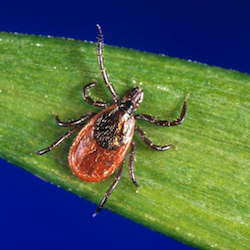SEJournal Online is the digital news magazine of the Society of Environmental Journalists. Learn more about SEJournal Online, including submission, subscription and advertising information.
Tipsheet: New Tack on Ticks — Infestations a Local Environmental Story
Late summer is a season when many Americans relish warm days, heading out of doors wearing shorts and sandals … and coming home wearing ticks.
Partly because of climate change, tick populations are rising in many areas of the United States. That means a higher risk of tick-borne disease.
Your audience deserves to know of the increased threat and what they can do to prevent it. And in the process, you as an environmental journalist may get a chance to tell some environmental stories.
Protecting against tick-borne disease
For starters, it’s worth reminding your audience that while the obligatory tick check is not fun, it’s a lot better to find the tick than to not find it!
Also let them know how to protect themselves and their families against ticks. Clothing, repellents, and behavior outdoors all matter. A hint: the insect repellent DEET works better than “natural” essential oils.
 |
| The blacklegged tick (Ixodes scapularis) is one of two varieties of tick responsible for most Lyme disease cases in the United States, which have tripled over the last 20 years. Photo: CDC |
Ticks are important to people because they transmit a good many very nasty diseases: Lyme disease, Rocky Mountain spotted fever, tularemia, Colorado tick fever, babesiosis, ehrlichiosis, tick-borne relapsing fever, Powassan virus and Bourbon virus, to name some. (Also see our Issues Backgrounder on insect-borne diseases.)
For instance, the incidence of Lyme disease in the United States has been rising steadily in recent years. Unless detected early and treated, it can be painful and disabling. In many parts of the country, tick populations are up — and there seems to be a connection.
Newsier still: There may be a rise in the number of tick-borne diseases that are threatening people in the United States. The diseases themselves may not be brand-new, but they may be becoming more common (“emerging”) here.
Is climate change worsening tick problem?
But there’s another big story. Ticks fit into local ecosystems — and local environmental health worries — in all kinds of ways. They are news because they affect people’s lives, but also because the conditions that bring them and the consequences that result are always changing.
Look at the “ghost” moose in Maine. They are thin as rails and dying. The ticks are eating them alive, or to be more precise, draining them of blood. Mortality is unusually high, especially among calves. This is going on across New England. The culprit seems to be global warming, which extends the tick season and increases tick numbers and activity in the winter.
There are hundreds of species of ticks, and in the United States there are at least half a dozen major species that bite humans. This CDC map shows the range of each. The interesting question is how that range is changing nowadays. Ask around the biology department of your local universities to see who might be studying this.
Climate change is changing the tick situation, as we see in New England. But it is hardly a simple connection, and not always clear. The population numbers of host species have been shown in many studies to relate to the numbers of ticks. Fewer hosts mean fewer ticks.
Some studies, for instance, have shown that culling deer to reduce their populations has cut the numbers of ticks. What is not yet clear is whether this cuts Lyme incidence.
Other environmental factors in spread
This year, scientists have been studying an explosion in the deer tick population on Long Island. A warmer climate is a factor. But there is also an abundance of acorns, which support a larger population of the voracious white-footed mice, who are the favored host of the deer ticks (which transmit Lyme disease).
And climate change isn’t just about warmer temperature — it can mean wetter or drier seasons. And that matters to ticks. More moisture during the late spring/early summer season promotes survival of nymphal deer (aka blacklegged) ticks.
To take another example, ticks (and the Lyme disease they cause) have been exploding in Michigan in recent years. In this case, some scientists think that abundant ticks from the Northeast have jumped the natural barrier of the Great Lakes by hitching rides on bird hosts.
Yet another recent study suggested that surges in the activity of white-footed mice (and thus ticks and Lyme) were resulting from scarcity in North America of mouse predators like foxes, weasels, fishers and martens.
Resources on ticks
If you have questions about ticks, you might take a look at the TickEncounter Resource Center at the University of Rhode Island. Another source is the Tick Project at the Cary Institute of Ecosystem Studies in New York. The Centers for Disease Control is a good source on tick-borne disease. The Lyme Disease Association may be another good source.
* From the weekly news magazine SEJournal Online, Vol. 2, No. 32. Content from each new issue of SEJournal Online is available to the public via the SEJournal Online main page. Subscribe to the e-newsletter here. And see past issues of the SEJournal archived here.













 Advertisement
Advertisement 



